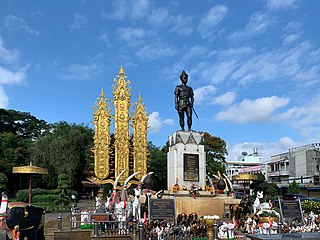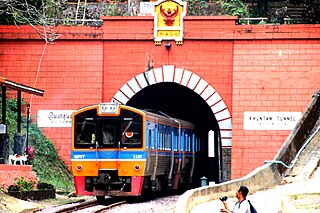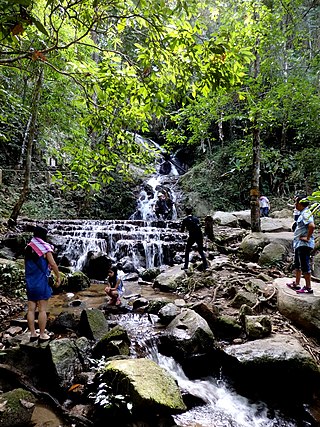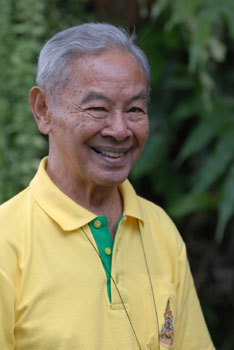
Chiang Rai is one of Thailand's seventy-six provinces, which lies in upper northern Thailand and is Thailand's northernmost province. It is bordered by the Shan State of Myanmar to the north, Bokeo province of Laos to the east, Phayao to the south, Lampang to the southwest, and Chiang Mai to the west. The provinces is linked to Houayxay Laos by the Fourth Thai–Lao Friendship Bridge that spans the Mekong.

Chiang Mai is the largest Province (changwat) of Thailand by area. It lies in upper northern Thailand and has a population of 1.78 million people. It is bordered by Chiang Rai to the northeast, Lampang and Lamphun to the south, Tak to the southwest, Mae Hong Son to the west, and Shan State of Burma to the north. The capital, Chiang Mai, is 685 kilometres (426 mi) north of Bangkok.

Lamphun is one of Thailand's seventy-six provinces (changwat), and lies in upper northern Thailand. Neighboring provinces are Chiang Mai, Lampang, and Tak.

Phayao is one of Thailand's seventy-seven provinces (changwat), and lies in upper northern Thailand. Neighboring provinces are Nan, Phrae, Lampang, and Chiang Rai. To the northeast it borders Xaignabouli in Laos.

Princess Srinagarindra born Sangwan Talapat was a member of the Royal Thai Family. She was part of the House of Mahidol, which is descended from the Chakri dynasty and was founded by Prince Mahidol Adulyadej. She was the mother of Princess Galyani Vadhana, King Ananda Mahidol, and King Bhumibol Adulyadej and was the paternal grandmother of King Vajiralongkorn.

Mae On is a district (amphoe) of Chiang Mai province in the north of Thailand.

Mueang Lampang is the capital district of Lampang province, northern Thailand.

Hang Dong is a district (amphoe) of Chiang Mai province in northern Thailand.

Doi Tung (ดอยตุง) is a mountain in the Thai highlands of Mae Fa Luang District, Chiang Rai Province, Thailand.

Prince Bhisadej Rajani (Thai: ภีศเดช รัชนี; RTGS: Phisadet Ratchani; complete title: His Serene Highness PrinceBhisadej Rajani; was a prince of Thailand, a member of the Thai royal family, and a member of the House of Rajani, a royal house which was originated by his father and descends from Chakri Dynasty. He was one of the longest-living royal personages in the Thai history. He was a close friend of the late King Bhumibol Adulyadej, who was also his third-degree cousin. In addition, he was also an author and worked as one of the directors of the Royal Project Foundation for the late king.
Wiang is a Tai word for "fortified settlement" or "walled town, city" of Austroasiatic origin, from Proto-Austroasiatic *wa(a)ŋ. This toponymic element forms part of the names of certain ancient inhabited places located in an area stretching across Northern Thailand and Laos:

The Daen Lao Range is a mountain range of the Shan Hills in eastern Burma and northern Thailand. Most of the range is in Shan State, with its northern limit close to the border with China, and runs southwards across the Thai border, at the northern end of Thailand.

The Phi Pan Nam Range, also Pee Pan Nam, is a 400 km (249 mi) long system of mountain ranges in the eastern half of the Thai highlands. The range lies mostly in Thailand, although a small section in the northeast is within Sainyabuli and Bokeo provinces of Laos.
The Mae Fah Luang Foundation (MFLF) is a private, non‐profit organization established to improve the quality of life of people in poverty and deprived of opportunities. It manages numerous projects in Thailand as well as other countries in Asia. The foundation's mission focuses on three main areas: “improving social and economic development, preserving the environment, and supporting local art and culture.”
The Doi Kham Company was founded in 1994 by the Crown Property Bureau at the request of King Bhumibol Adulyadej to set up a business to buy products from royal projects and farmers at fair prices and sell quality products to the Thai population.
The 42nd Thailand National Games were held in Suphan Buri, Thailand from 5 to 15 January 2014, involving 44 sports and 77 disciplines. These games were held in Suphan Buri Provincial Sport Center and Suphan Buri Sport School Stadium. Nakhon Ratchasima also hosted the 1994 and the 2006 Thailand National Games.
Wat Chan Royal Project is a development project in Chiangmai, Thailand, to replace opium production with other form of agriculture.
Khun Chang Khian is a village administered as Moo 4 in Chang Phueak tambon (subdistrict) of Mueang Chiang Mai District, in Chiang Mai province, Thailand. In 1999, it had a total population of 697 people. It is a White Hmong village that was founded in 1955. The village is located to the east of Doi Pui and is approximately 1,350 metres (4,430 ft) above sea level.













